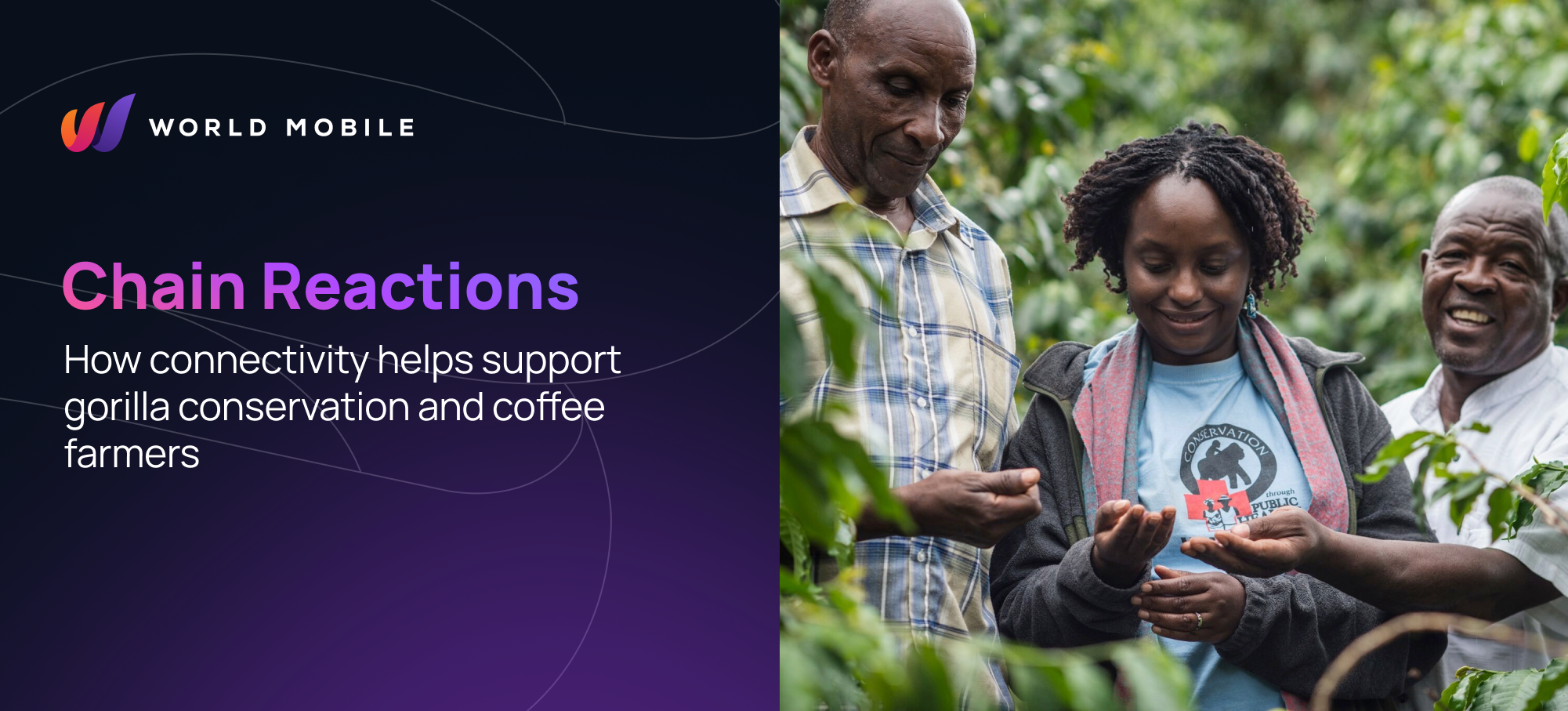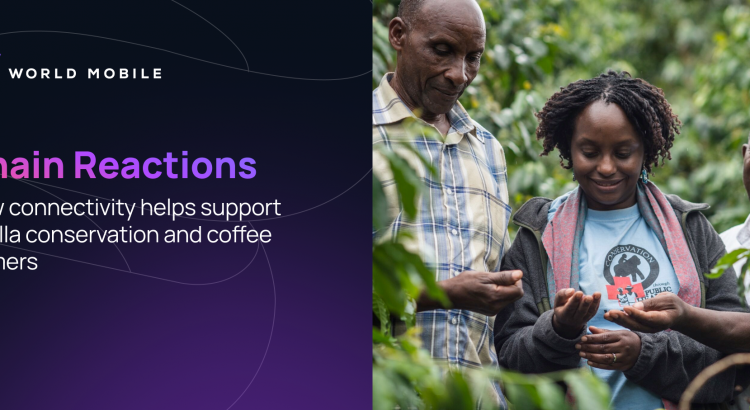
SOURCE: WORLDMOBILE
How can connectivity help support gorilla conservation and coffee farmers’ livelihoods?
As you’re sipping your morning coffee – maybe in a little independent café in a big city – did you know that, thanks to a social enterprise in a rainforest in southwestern Uganda, you may be helping gorilla conservation in East Africa?
OK, so let’s start at the beginning.
Uganda has one of the last remaining populations of endangered mountain gorillas in the world. There are around a thousand in the wild, with half of these in Bwindi Impenetrable Forest, southwestern Uganda. This area is covered by one of the country’s oldest and most biologically diverse rainforests and is a popular spot for tourists. Here they can go gorilla trekking, which brings in important income for the local communities living on its boundaries.
But the relationship between gorillas and the human communities is not always a happy one. With population pressure in already marginalised communities comes encroachment on habitats – both villagers going into the park for food and resources, as well as primates coming to feed on crops. Due to their close proximity, infectious diseases can pass between humans, gorillas and livestock, including Covid-19. Poaching for bushmeat in the park is also a problem, which escalated during the Covid-19 pandemic while the park was closed to the public. The potential for interaction between humans and gorillas increased, leading to disease transference.
So how can we help gorillas and humans coexist?
Just a 20-minute walk from the gorilla trekking start point at Bwindi Impenetrable Forest National Park is the gorilla health and community conservation centre of not-for-profit, Conservation Through Public Health (CTPH). The organisation was founded in 2002 by award-winning Ugandan conservationist and vet, Dr Gladys Kalema-Zikusoka. She recognised that for human and gorilla populations to coexist successfully, primary healthcare needed to improve. So for the past 20 years, CTPH has been running a series of projects working with both gorilla and human communities, including gorilla health monitoring, youth engagement and participation of women in activities.
But what’s that got to do with coffee?
Many farmers living adjacent to the forest grow coffee, but Dr Gladys and her team discovered that they weren’t getting a fair price for their produce. Other than coffee farming and tourism, there are few livelihood opportunities for these marginalised groups. And without a fair price for their coffee crop, this impacted on their ability to support their families and access healthcare and other social services. Many resorted to taking food and wood for fuel from the national park, thus increasing the risk of disease transference to gorilla populations.
And so in 2015 Gorilla Conservation Coffee was born. This social enterprise enables coffee farmers to have a viable livelihood through access to the markets. And because the farmers are earning a better living, their need to enter the forest for food and firewood is reduced, resulting in reduced threats to gorillas and their habitats.
Gorilla Conservation Coffee pays farmers living around Bwindi Impenetrable Forest $0.50 per kilo above the market price. For each kilo sold by the enterprise, $1.50 is donated to CTPH’s work supporting gorillas and the communities living nearby. They currently work with around 550 farmers, one third of whom are women. It should be noted that the involvement of women is crucial – often they are excluded from formal income generation and economic opportunities yet hold responsibility for the basic needs of their households.
But help for the coffee farmers does not stop there. The project also offers training in sustainable coffee farming and processing, which improves quality and increases yields. And it’s paid off. In 2018, the coffee was ranked in the top 30 in the world in the coffee-buying guide, Coffee Review (www.coffeereview.com).
One of the places you can buy the coffee is a hotel and NGO for women who have suffered domestic violence – Ride 4 a Woman in Buhoma, Bwindi. In addition to selling coffee and providing accommodation, the women also make crafts to sell to tourists, giving them with an income, whereas previously some had been making ends meet by burning charcoal or taking bushmeat from the forest. With this project, they now appreciate the benefit of tourism – they gain employment plus recognise that protecting the gorillas and working with Uganda Wildlife Authority (UWA) is beneficial to them and their livelihoods. And when there are no tourists, they can still earn a revenue from the coffee.
How does connectivity help?
If you were to discover that Sir Tim Berners-Lee visited a telecentre in Uganda’s Queen Elizabeth National Park ran jointly by CTPH and UWA, then you’ll realise how seriously they take connectivity and the opportunities that arise from access to the internet. The telecentre, opened in 2007, offered a community portal in the local language, links with schools in the community and the USA, and web and IT skills training to the community (it is interesting to note that more than 40% of community members trained in computer literacy were women). A couple of years prior to this, a similar centre had been opened in Bwindi.
In 2007, HRH Prince Philip, Duke of Edinburgh, sent the first official email from the QENP Telecentre.
In 2022, the telecentre at Queen Elizabeth National Park – at Queen’s Pavilion Crater Drive Gate – remains open as an UWA Visitor Information Centre/CTPH Telecentre for tourists to use as an internet café if required. But with the abundance of smartphones, the telecentre in Bwindi is no longer necessary. However, the need for connectivity and accessibility is still very much a feature of Gorilla Conservation Coffee’s model.
It’s important to the social enterprise that the coffee is ‘traceable’ in order to shore up the sustainable brand narrative, and then to be able to share that to a wide audience. After all, that’s what makes them so special. Creating this brand awareness is key to the success of the coffee and by default the livelihoods of the communities (both human and primate). Extensive use of social media platforms and podcasting, for example, are part of the coverage, targeting tourists and potential partners. Tourists get to hear about the coffee story, then may book both a ‘coffee safari’ (meeting the coffee farmers and learning how it is grown and processed) and a gorilla trekking experience at CTPH.
With connectivity and the abundance of smartphones comes other advantages to the community. Smallholder farmers can pay school fees online. Tourists can scan QR codes to buy fresh produce which can then be sent to their home addresses to arrive when they return from their travels. The incredible experiences of gorilla trekking and meeting the coffee farmers can be shared on social media. And farmers can see their coffee being sold and consumed far beyond the boundaries of their farms and locality.
This ‘giveback’ model covers all the bases – gorillas, humans and the health of both. But you don’t even have to visit the gorillas in Uganda to take part, you can buy the coffee! The beauty of this model is that it could also work anywhere in the world where there are gorillas (eastern and western lowland gorillas, for example), chimpanzees or other species that coexist alongside cultivated land.
As can be seen here, reliable access to the internet can have significant impacts, way beyond what you might imagine. And this is why World Mobile continues on its mission to connect the unconnected.
If you’re interested in finding out more about the World Mobile ecosystem and our mission, check out the links below:
